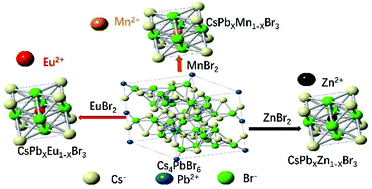The luminescence properties of CsPbxM1−xBr3 perovskite nanocrystals transformed from Cs4PbBr6 mediated by various divalent bromide MBr2 salts†
Abstract
A novel high concentration doping method based on the transformation from Cs4PbBr6 nanocrystals (NCs), which reacted with divalent metal bromide MBr2, to CsPbxM1−xBr3 NCs was developed. Two types of M2+ and Zn2+ which cannot emit light and Mn2+ and Eu2+ which can be used as the luminous centres, were chosen to trigger the transformation of Cs4PbBr6 NCs to CsPbxM1−xBr3 NCs. CsPbxZn1−xBr3 NCs maintained high photoluminescence quantum yields (PLQY) (>75%) and had good dispersion in hexane without obvious dissolution or agglomeration after two weeks. By adjusting the reaction temperature, the intrinsic band edge luminescence and the emission of Mn2+ ions CsPbxMn1−xBr3 NCs show different colours of light from green, green-yellow, pink, and orange-red to purple under an excitation of 365 nm. CsPbxEu1−xBr3 NCs were synthesized for the first time, and a weak luminescence around 618 nm from Eu3+ was detected in addition to the band edge luminescence of NCs. X-ray photoelectron spectroscopy (XPS) data showed that Zn2+, Mn2+ and Eu3+ (Eu2+) doping concentrations are up to 80%, 75% and 50%, respectively. We also analysed the doping mechanism and compared the new method with the traditional high temperature injection method. The lead-depleted perovskite NCs transformed from Cs4PbBr6 can provide a feasible pathway to reduce the lead toxicity of perovskite NCs and expand their applications.

- This article is part of the themed collection: Halide Perovskite Nanocrystals


 Please wait while we load your content...
Please wait while we load your content...